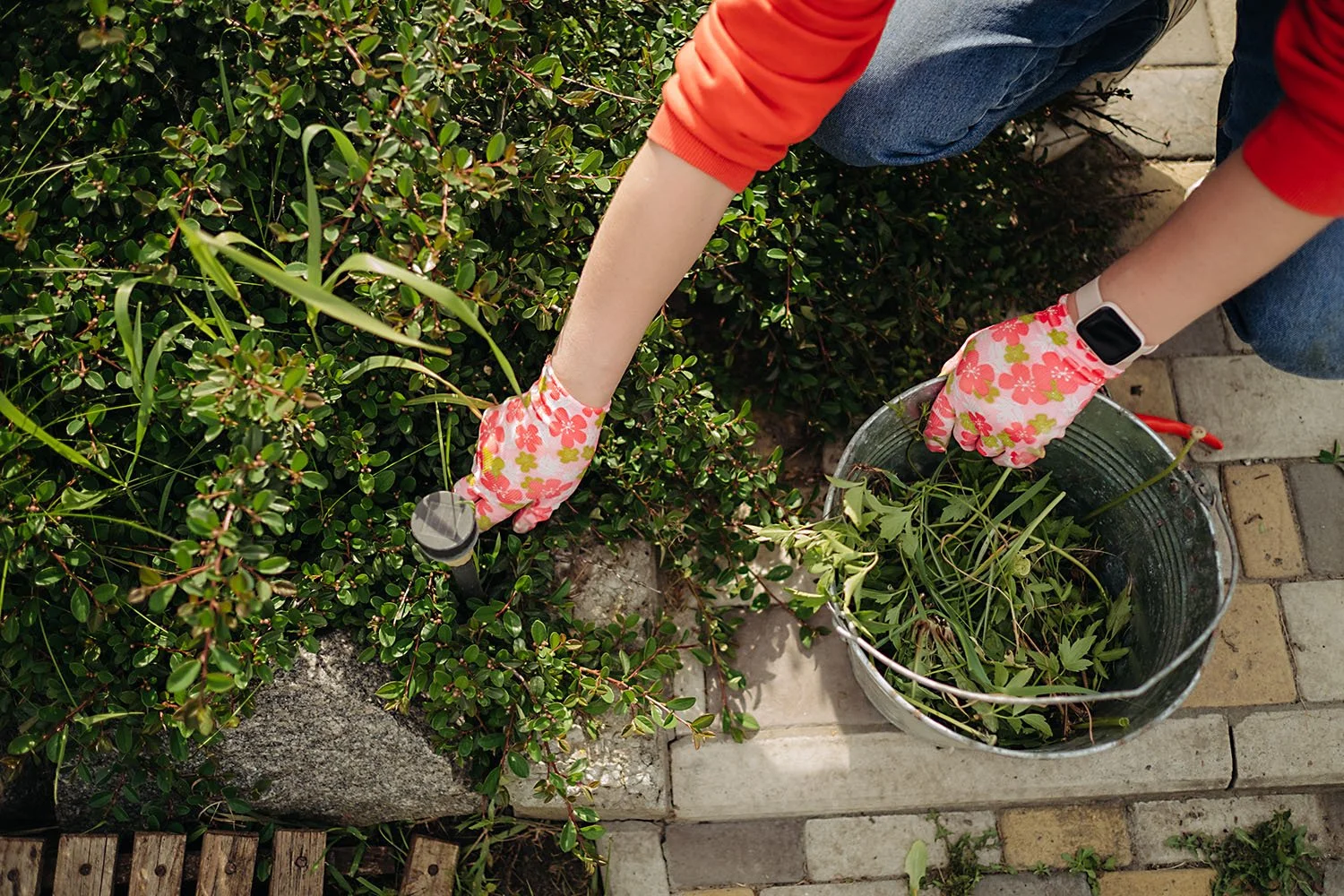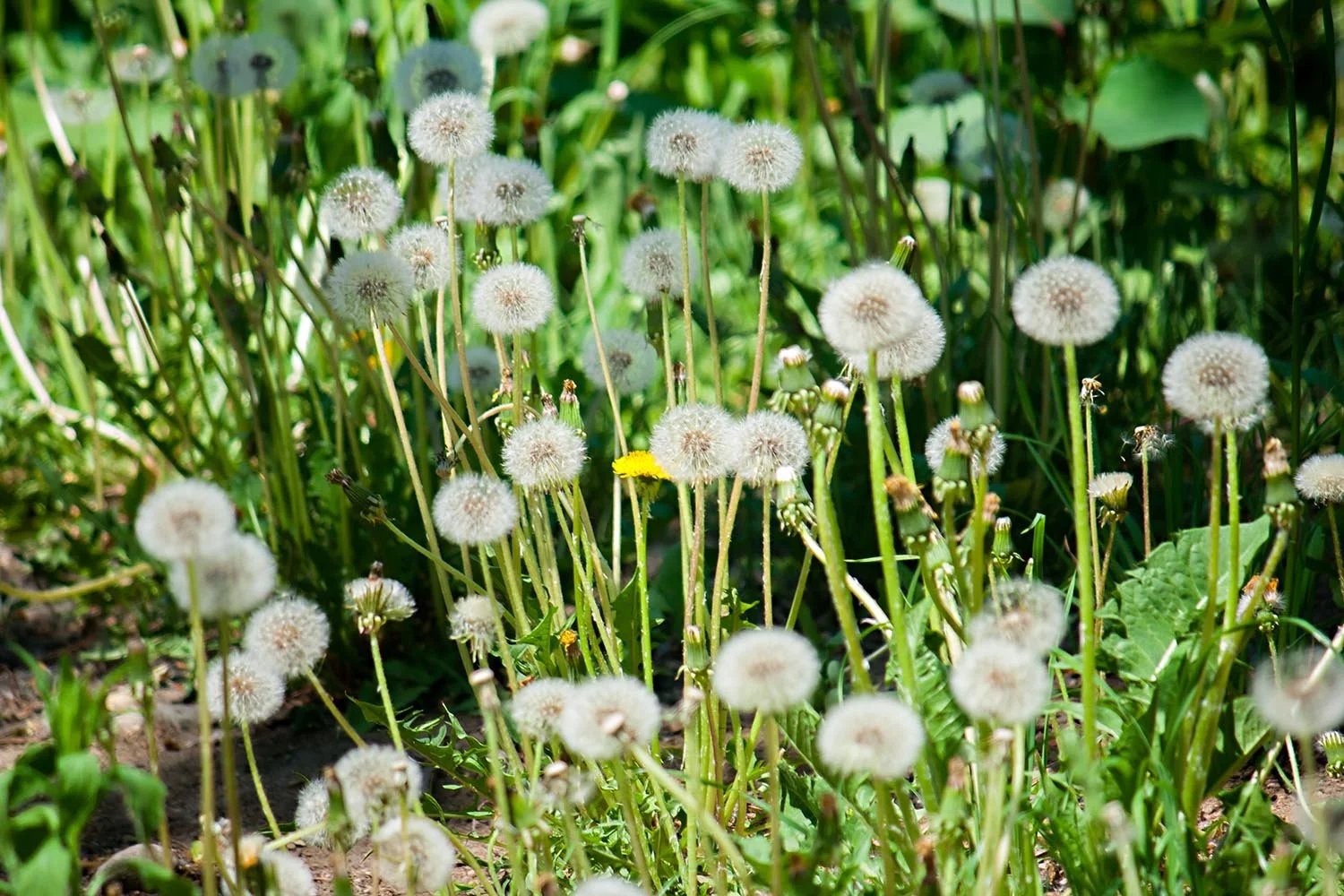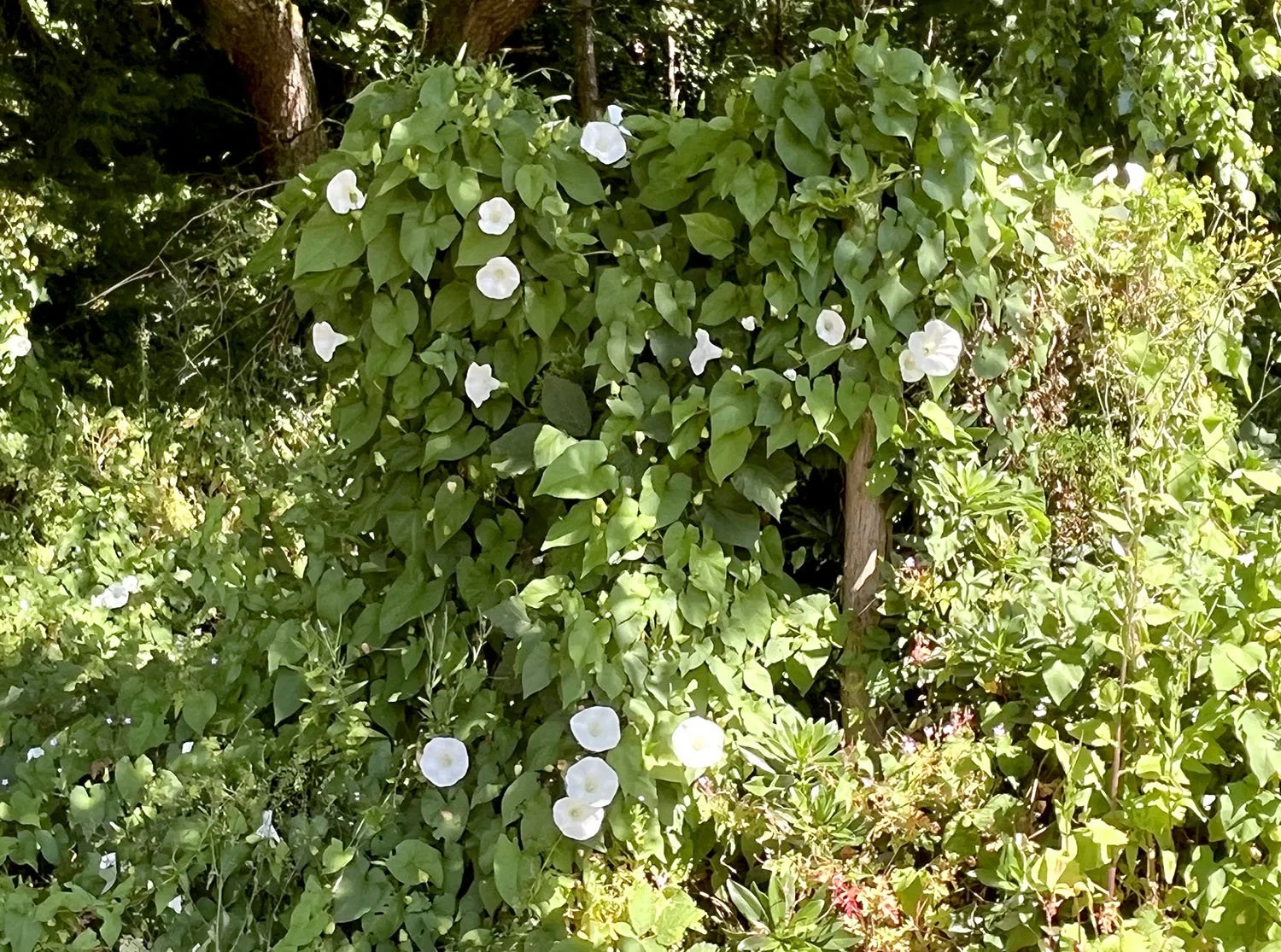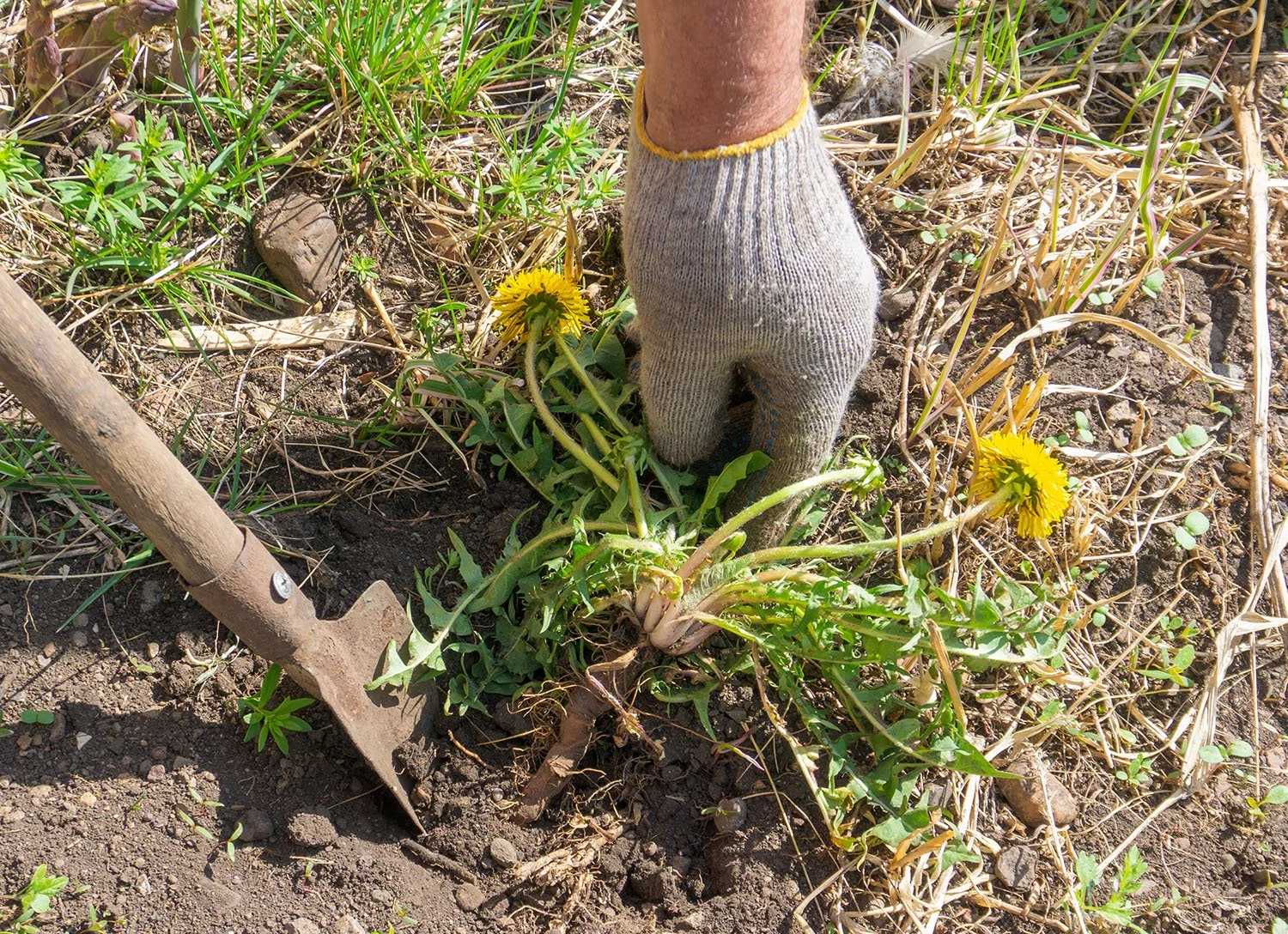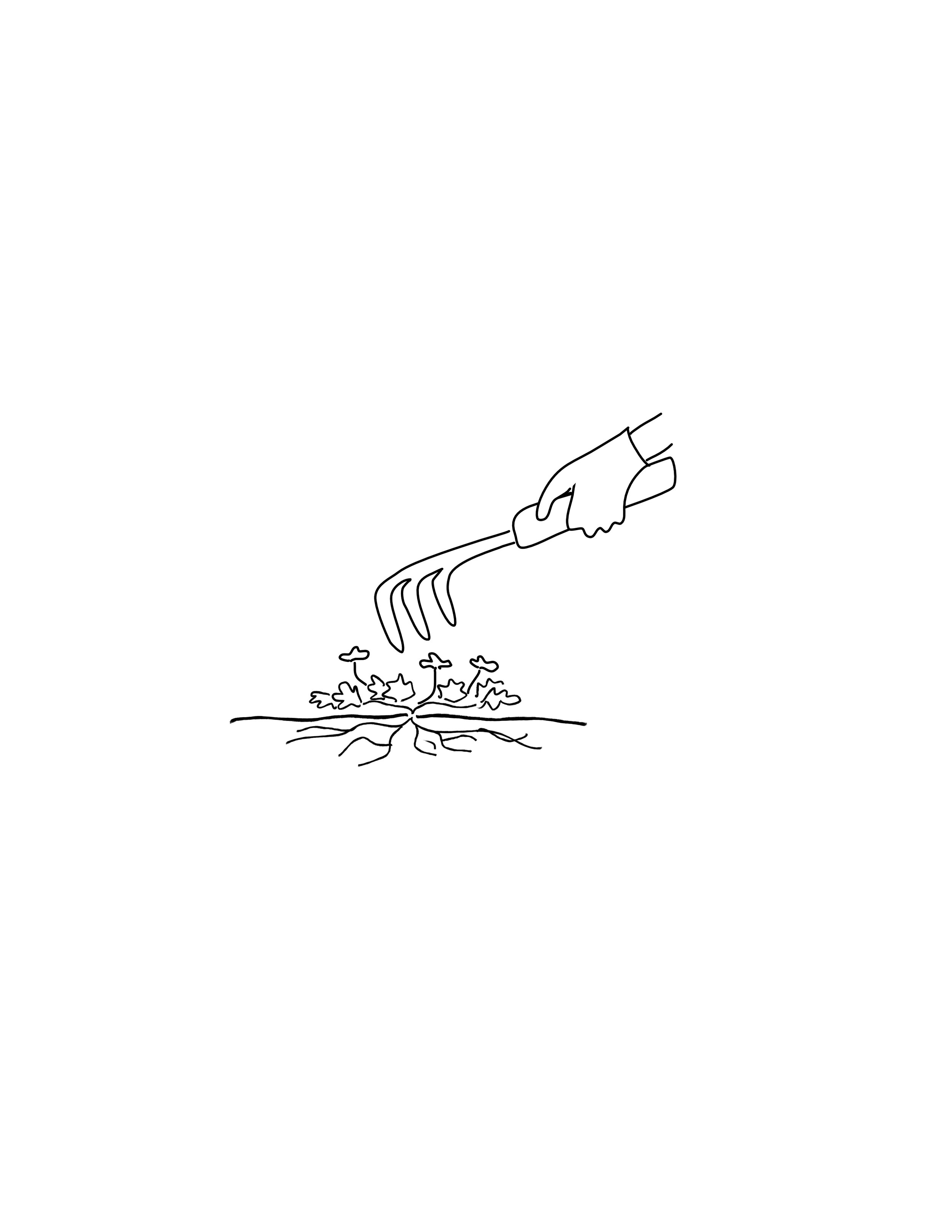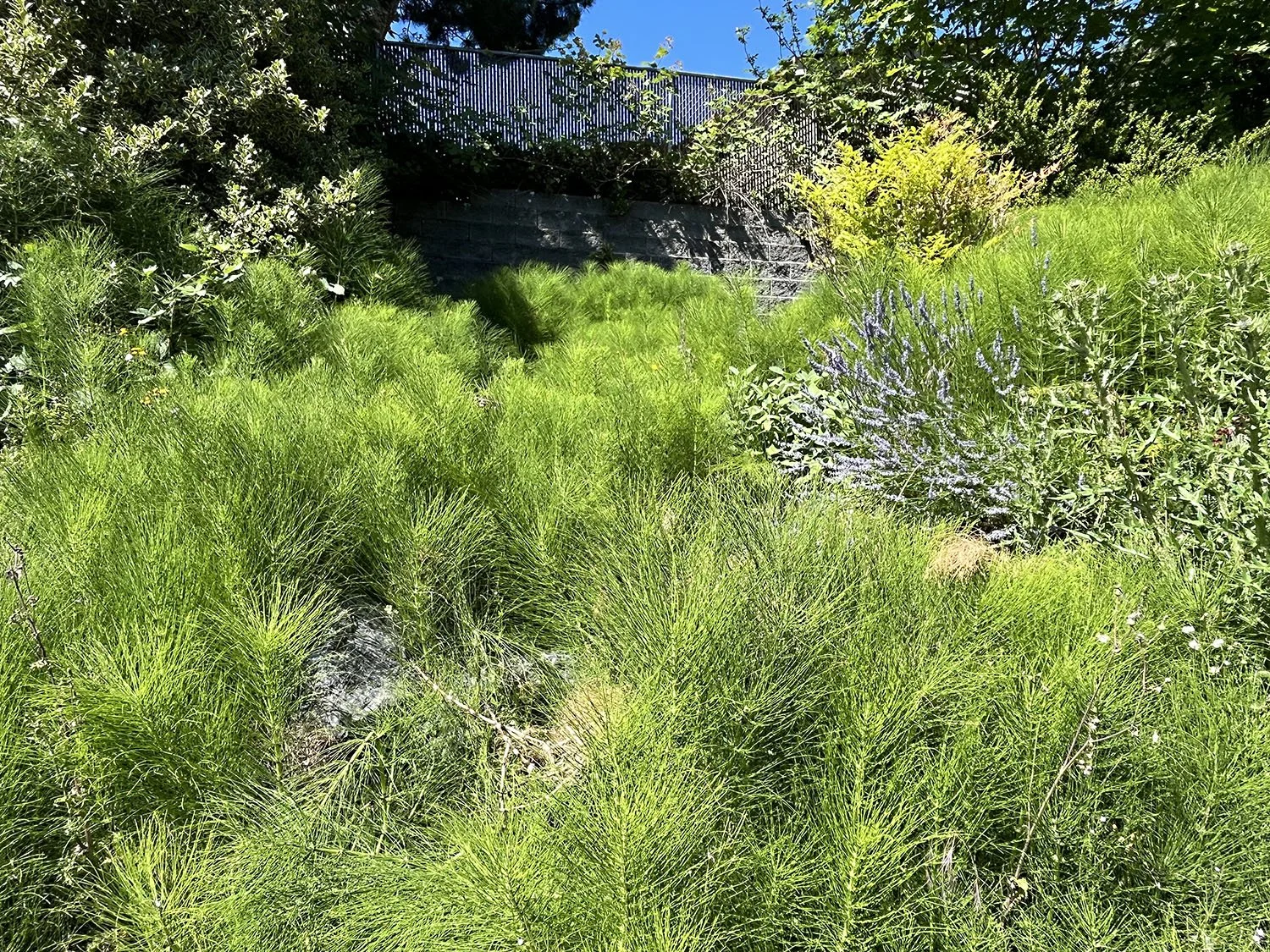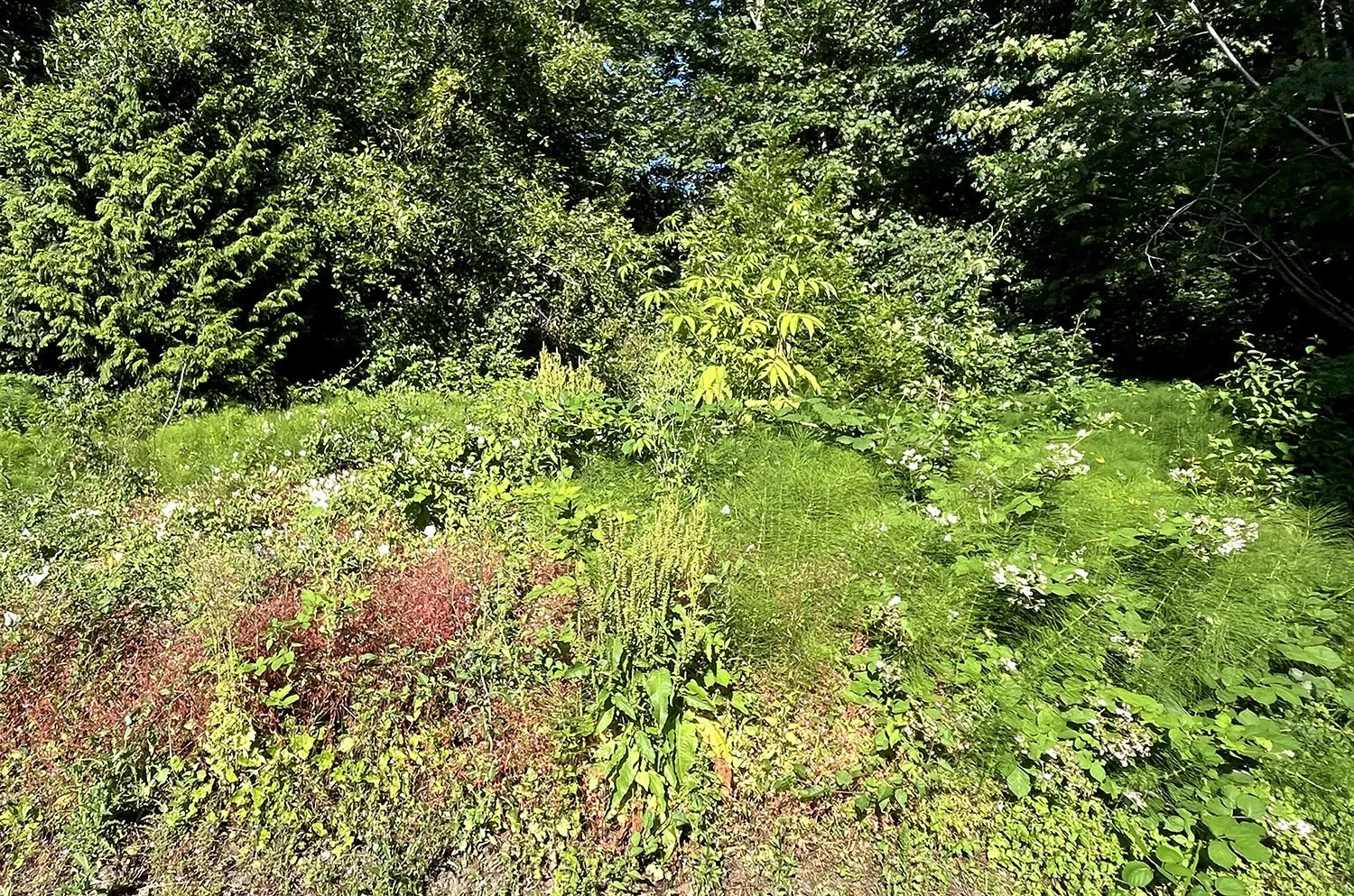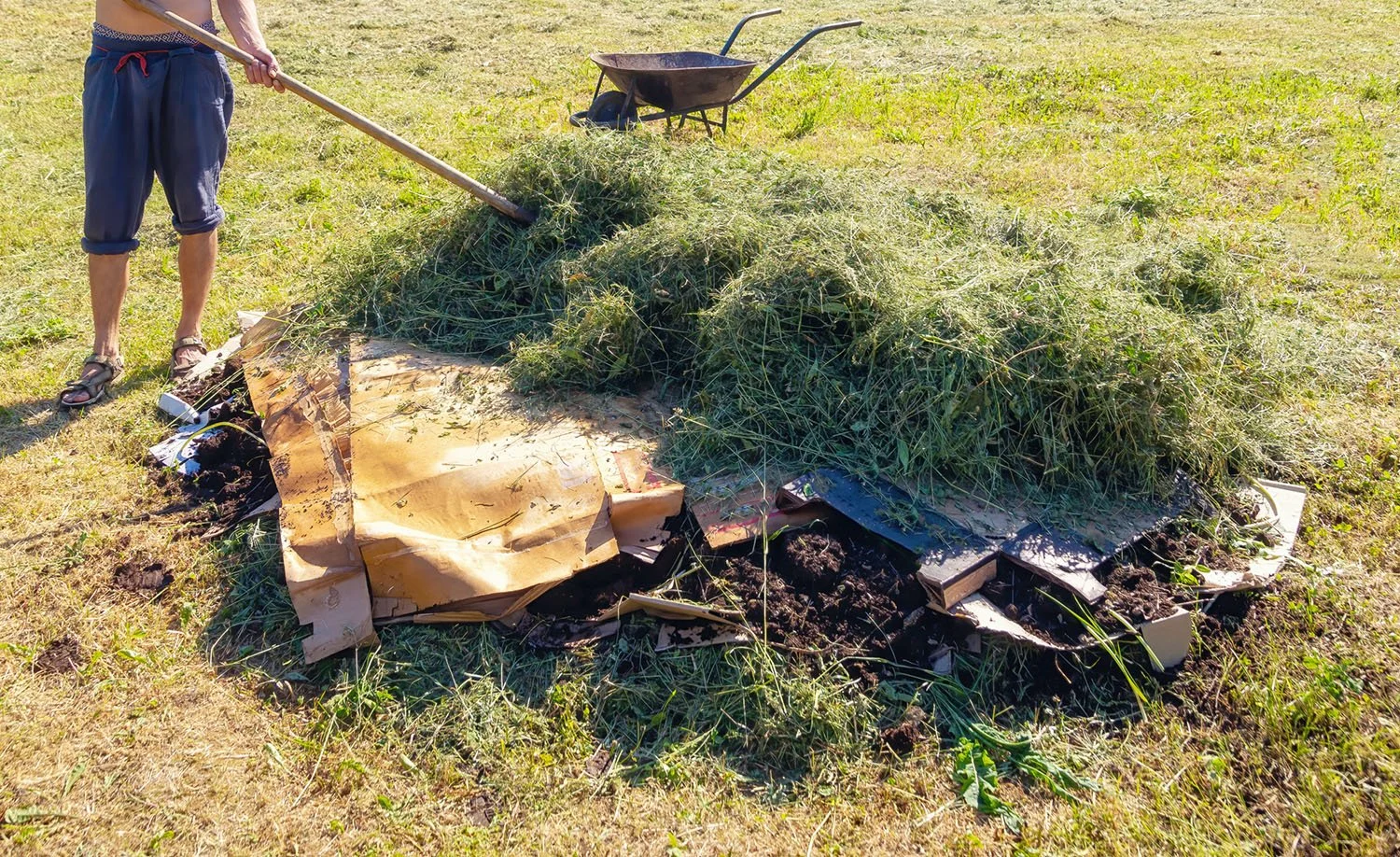We at Swansons spend a lot of effort persuading gardeners that the sudden appearance of critters, diseases, moss, or other unplanned visitors does not necessarily require a Universal Call to Arms. Sometimes they are part of a natural cycle and will soon pass if you just protect your favored plants for a while. Some visitors might even be beneficial, or expose imbalances in your garden (e.g., too wet, too shady, too heavily fertilized).
It's the same story with weeds. These opportunistic plants would love to share your garden’s soil space, but their sudden appearance need not necessarily trigger an emergency response.
How do you decide which weeds to live with, and which weeds to attack post-haste? It helps to understand which weeds you’re dealing with, why they show up, and what they want. And it makes a difference in your strategy whether you are doing individual spot-weeding vs. eliminating a large area at once (such as preparing to start a vegetable garden).
Types of Weeds
Some regular — if not always welcome — visitors
Is it a weed?
You've heard the definition, "A weed is merely a plant in the wrong place." Some are fine in the wild, beneficial for soil and other organisms, even nutritious and medicinal, but can be crazymakers for us human gardeners. Others are noxious and invasive to the point that your local government can require property owners to control them.
In nature, some “weeds” have recognizable ecological benefits for the soils they are trying to colonize. The dandelion taproot burrows deep into compacted, infertile soil, and helps to break it up, giving nutrients and beneficial organisms access to deeper soil layers. Clover adds nitrogen and other nutrients; we sell it as a cover crop. Horsetail is able to establish in barren areas (as, famously, in the blast zone of Mt. St. Helens) and add essential minerals, adapting soil for future plant growth. But of course, these plants grow and reproduce much faster than what we want in places such as a lawn or vegetable garden. Thus, we label them as weeds and gear up for battle.
Pervasive weeds
Horsetail and buttercup are a few of the many weeds that can be particularly hard to eradicate. We often call this type of weed a pervasive weed and sometimes need a more strategic approach is necessary, such as improving soil drainage.
Noxious weeds
Then there are noxious vines and colonizing plants imported from somewhere else (some intentionally, some not), which have escaped and seem bent on covering our planet, such as Himalayan blackberry, English ivy and bindweed (commonly, if inaccurately, known as morning glory vine). Managing these is a similar strategy as with smaller garden weeds but, like for pervasive weeds, on a different scale and time frame. King County has a list of noxious weeds and more information on why it is important to eradicate them.
Bindweed, sometimes called morning glory vine
Whatever the weed, basic prevention comes down to three main goals:
Make your garden spaces less attractive to weeds.
Keep weeds from reproducing by removing or containing their seeds or running roots.
Keep weeds from reaching sunlight, which feeds their roots.
Let’s look at the best ways to meet these goals. But first, a note about IPM.
IPM - a logical step approach the problem
At Swansons we strive to follow the principles of Integrated Pest Management (IPM) a common-sense approach that emphasizes getting the diagnosis accurate, then first trying solutions that minimally impact the rest of your garden and ecosystem, and only using more toxic solutions if nothing else is getting results. For weeds, the IPM approach might be making sure the garden is healthy, then digging weeds by hand, if feasible, then trying organic remedies, and finally, if needed, moving temporarily to chemical solutions for the toughest weeds.
Basic Prevention: Making Your Garden Spaces Less Attractive to Weeds
Make sure soil & plants are healthy
Just as with your own body fending off pathogens, if you can keep your plants and soil as healthy as you can, weeds and other pests are less likely to get a foothold. So appropriate watering, mulching, fertilizing, pruning, etc. will all help make your garden plants more competitive and resilient. Sure, you'll have to deal with weeds at some point, but preventative measures can minimize them.
Make sure your soil is in good shape, getting the nutrients it needs and watering properly before you plant. This is critical during the first couple of years while plant roots are getting established. If your plants can get a healthy start and grow quickly and densely, they will have a better chance to out-compete weeds.
Plant densely
Large patches of bare soil which are exposed long enough will be colonized by something. If not your intended ground-covering plants, it might be moss, shotweed, blackberries or something else you didn't ask for. Plan to cover any bare soil with plants, or temporarily with mulch if planting isn't feasible for now. When you do your ornamental planting, make it dense enough so your plants grow together to form weed-suppressing groundcover or shade within 3-4 years.
Plant diversely
Planting a diversity of plants in a shrub or perennial bed has many advantages including year-round interest, and supporting a variety of pollinators and wildlife. It also makes any weeds that do appear less conspicuous than if they invaded a mass planting of one or two species. You shouldn’t ignore those weeds indefinitely, but at least they won’t embarrass you as quickly!
Mulch
Mulches won't prevent weeds forever, but they're way better than leaving your soil bare. Any weeds which get started are usually easier to pull out of 3+ inches of mulch. Plus, composted mulching provides many other benefits to your soil — conserving water, preventing erosion, and helping to build and maintain a healthy microbial community. It is especially helpful for minimizing weeds among vegetables, annuals, or other short-term plants, where you often have exposed bare soil.
Managing Weeds: Keeping Weeds from Reproducing by Removing or Containing Their Seeds or Running Roots
If you're doing all the right things to keep a healthy garden but the invaders just keep coming, here are actions you can take.
Physical control — get digging!
I know... why suggest the unpleasant task of digging them when it's so easy to just spray? There are lots of reasons to minimize spraying from a health perspective (for plants and other organisms, including you). But hand weeding can go much smoother with a few tips in mind.
It's generally easier and more effective to weed in spring, late fall, and even winter. Other than the soil moisture factor, these are when weeds are often younger and haven't yet bloomed or set seed (see below). But many don’t become evident until summer and, of course, you should pull 'em when you see 'em.
Moisten the soil if it's dry. Compacted, dry soil is the hardest situation for pulling weeds. And it's common — that's often why the weeds are there, as the only plants which tolerate such soil. If you can, give a good soaking to the area to be weeded a day before you attack it.
Get as much of the root as possible. If you just snap a weed off at the surface, leaving the root intact, it will likely grow right back in a few days or weeks. Use a weeder (narrow prong tool), hori-hori knife, trowel or spade (for big, deep weeds) to probe down beside the root and loosen the soil around it. You might need to dig from two or three sides if the root is deep or persistent. You still might not get the entire root, but even pulling the top few inches can slow its ability to regenerate.
Some shallow-rooting weeds root so densely that you need to pull up a whole section, soil and all, like pulling up sod. Buttercup and many weed grasses are in this group. It may help to use a multi-prong cultivator to grab and pull. Once they’re up, you can use the same tool to knock as much soil as possible off the roots before tossing the weed. Just make sure they’re not setting seed to fall back into the soil.
For small or shallow-rooted weeds, light surface tilling with a hoe or other tool (then raking up the loose weeds) provides quick easy control. This works for vegetable rows and other situations when you maintain areas of bare soil. But it's cumbersome in tight spaces among denser plantings, and much less effective for dandelions and other deep-rooters.
Pull weeds before they set seed, if possible. Of course, some seem to emerge from the ground and set seed overnight! If a weed is already seeding, try to gently gather it up without scattering the seeds. It might help to cover it with a bag, towel, or tarp to contain seeds. You won't get them all, but at least you'll slow their ability to propagate.
Safety notes for hand pulling: some weeds are thorny; some have caustic sap. Not to mention spiders and other biting critters may be with them. Gloves and eye protection are always a good idea, especially if you don't know the weeds you're dealing with. Also, avoid pulling weeds during hot sunny weather, unless you're in it for the tan on your back and neck. Like most garden tasks, weeding is a physical job and heat stress can sneak up on you. On those days, do it in early morning or evening if that's an option.
Spraying
As with any spraying for weeds or pests (regardless of whether they are natural or not), take steps to target the spray only toward plants that need it to avoid harming innocent bystanders. To that end, spray in the morning or later evening when the wind tends to be lower and fewer insects — especially bees — are active. If you're using something that might harm many types of plants, consider covering nearby plants to shield them from overspray. Use spray bottles that have a stream as well as spray nozzles. Or, if necessary, dab the solution on with a sponge or other small applicator.
Sometimes it's impossible to avoid collateral damage, especially in situations like lawn weeds. If you create a larger dead zone than intended, it’s wise to replant or reseed very soon so new weeds don't jump right back in.
Home remedies
The lead actors among natural garden solutions are vinegar and lemon juice. One popular recipe for weed killer calls for a gallon of vinegar, a cup of salt or borax, and a tablespoon of dish soap. Caution: although they’re “natural,” vinegar and lemon juice are highly acidic, thus toxic to most plants. Salt and borax can sterilize the soil. Use these solutions sparingly and specifically on the weed plants you wish to kill, but minimize contact with neighboring plants and soil as much as possible.
Commercial remedies
At Swansons we carry an array of weed treatments. Depending on the type of weed, they can be “selective” control that can be applied to turfgrass and kills only broadleaf weeds in the lawn, or “non-selective” (kills most plant types that it contacts). Some are available in more than one form: ready-to-use sprays, liquid concentrate, or granules.
Here are three of our most popular weed remedies produced by Bonide®, a brand we trust:
Weed Beater® Ultra
A selective killer for a wide variety of broadleaf weeds in lawns. Weed Beater® Ultra Fe includes iron (Fe) to control moss. Will not harm lawn or other grasses, but toxic to any broadleaf plant.Burn Out™
A non-selective (can kill any grass or broadleaf plant it significantly contacts) with active ingredients: citric acid and clove oil.Brush Killer BK-32
A selective killer for tough brush, woody weeds, and vines. Will not harm lawn or other grasses, but toxic to any broadleaf plant.
Note: We strongly recommend using caution and discernment when using any herbicide, whether natural or chemical, to prevent harm to surrounding plants, beneficial insects, aquatic life, animals, and people. Read the label directions completely (online, if the print’s too small). Use gloves and eye protection, target your application to the specific weeds you're trying to kill, avoid spraying on windy days, and try to spray in early morning or evening when bees and other critters are less active.
Strategies for Pervasive Weeds: Keeping Weeds from Reaching the Sunlight That Feeds Their Roots
Horsetail, with a side of blackberry and thistle
You know the gang: Himalayan blackberry, English ivy, Japanese knotweed, horsetail, and bindweed (commonly, if inaccurately, known as morning glory vine). Most of these weeds spread quickly from seed or creeping roots, which seem to keep coming back no matter what. The fleshy, easily-breakable roots of horsetail and bindweed make them particularly challenging to eradicate.
The goal is to outlast them — starve ‘em out by cutting, pulling, or spraying any top growth you can find. These weeds’ roots need leafy top growth to capture sunlight and feed them. If you keep eliminating anything above ground, it can take a few years to finally starve out the roots, but this is the best long-term solution. Then, make sure any bare soil areas (especially in sun) are planted or mulched to discourage future weeds.
Himalayan blackberry
For Himalayan blackberry, it helps a lot to first cut canes a foot or two off the ground, and gather loose vines with rakes or leather-gloved hands. Then dig at the cane bases to reach any root crowns (the knotty clump where top stems meet roots) a few inches below the surface. Pulling up the crowns might not eliminate it but will significantly delay any remaining roots from sprouting again. Look carefully for signs of other root crowns or runners nearby.
English ivy
English ivy covers so densely that it can feel overwhelming to even start pulling it. So plan your attack in smaller campaigns. Consider just cutting any ivy which is climbing trees or structures for this year, then plan to pull up the ground patches in sections over time. It’s fairly easy to pull up the roots of ivy, but there’s often so much of it that you need to go over the space several times.
Horsetail
Horsetail is a primitive plant whose roots are not affected by common weed killers. So consistently cutting (a few inches deep) to prevent it from getting sunlight seems to be the only effective control. It also has a strong preference for wetter soils, and generally full sun (although can reach light in shady areas too). So if you can take steps to dry out the soil in that area, aerate it, lower its acidity, improve its fertility and/or plant ground-covering shrubs or shading trees, the horsetail will be less likely to stay and spread in the future. If it’s going to remain a naturally wet area, you might need to accept native horsetail as part of the natural flora there.
Bindweed
Bindweed draws our foul language for its aggressive twining, soft, easily breakable root sections, and sheer sneakiness. As much as possible, dig to loosen soil wherever you are pulling up bindweed roots so they don’t snap off at the surface. Just get as much as you can each time, watch for it popping up a few yards away from where you last pulled it.
The same strategy of "cutting and starving" applies to persistent sprouts from the roots of large trees which have been cut down, such as flowering cherry, birch, poplar, locust, or some maples. If you don't want them to keep sprouting, keep pruning them to the ground before they can leaf out as much as possible, and the roots will eventually starve out. Again, it takes persistence for a few years or more, but the alternative is major digging or chemical control.
A note on weed grasses
You might find a lot of information online about controlling specific grasses, such as crabgrass or quackgrass, but the strategy is similar no matter what the species. And it's pretty much the same as with the above-mentioned pervasive weeds: get them before they go to seed and starve them out by not letting them reach sunlight.
Weeding Large Spaces
Maybe you have a large space growing weeds (or even lawn), where you intend to start a vegetable garden, perennial bed, or other project. How you weed that space all at once is a little different approach than if it's already planted and you're trying to control individual weeds interspersed with your existing plants.
Sheet mulching
You could certainly dig or spray your plot. Or you could diligently cut down weeds and aggressively plant and nurture desired plants, for several years, to out-compete them. But perhaps the easiest, and most environmentally-friendly method is sheet mulching: covering the ground with material that allows moisture but not sunlight to penetrate. Cover the entire area with a couple of layers of newspaper (if you can still find enough of it), cardboard, or another porous, biodegradable material. Cover that with at least 6 inches of leaves, grass clippings, and/or organic mulch. Water it all in well. After somewhere between two months (for mostly lawn and/or small and grassy weeds) and a year or more (for deep-rooted, woody weeds), this starves out the roots so you can till dead weeds, rotted sheet materials and all, into the soil for planting the new project!
Yes, the truth is that weeds are just part of Gardening… part of Life. But with this information, we hope you can see them not as a failure of your skills, but as an expected and manageable challenge when you take them on with a lot of knowledge and a little patience. Or is it vice-versa?

